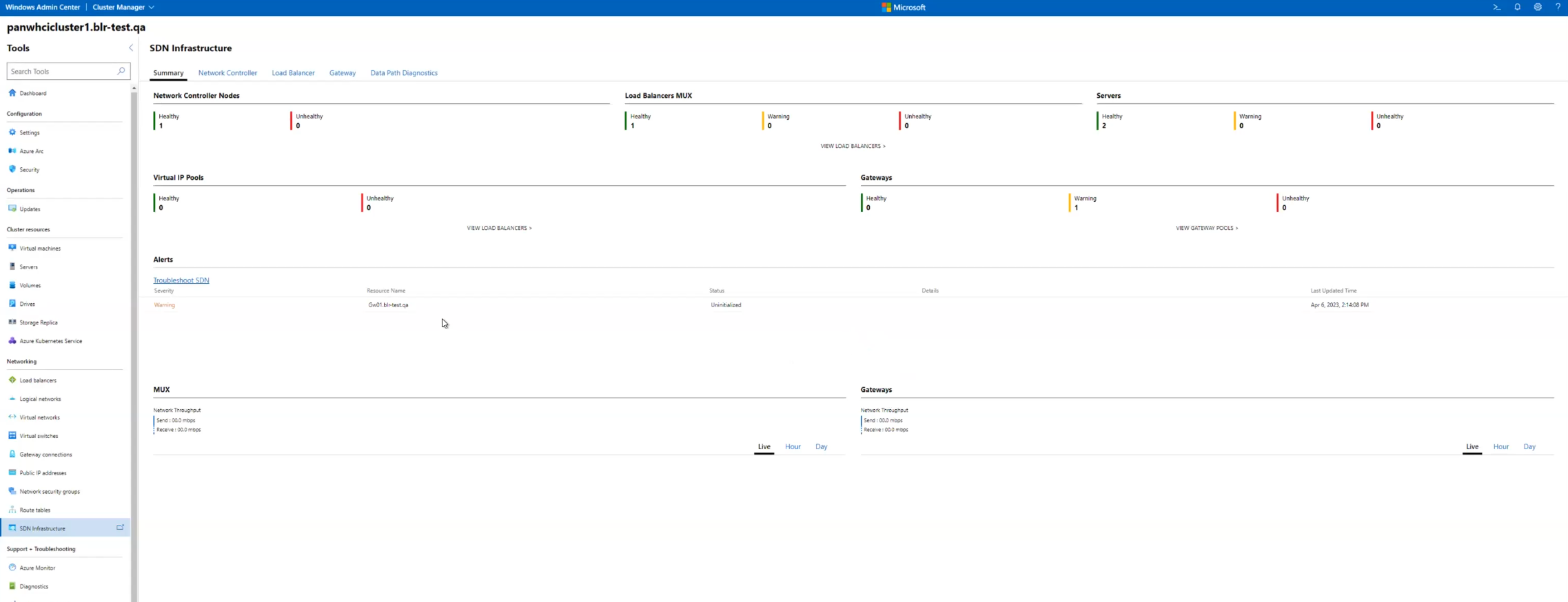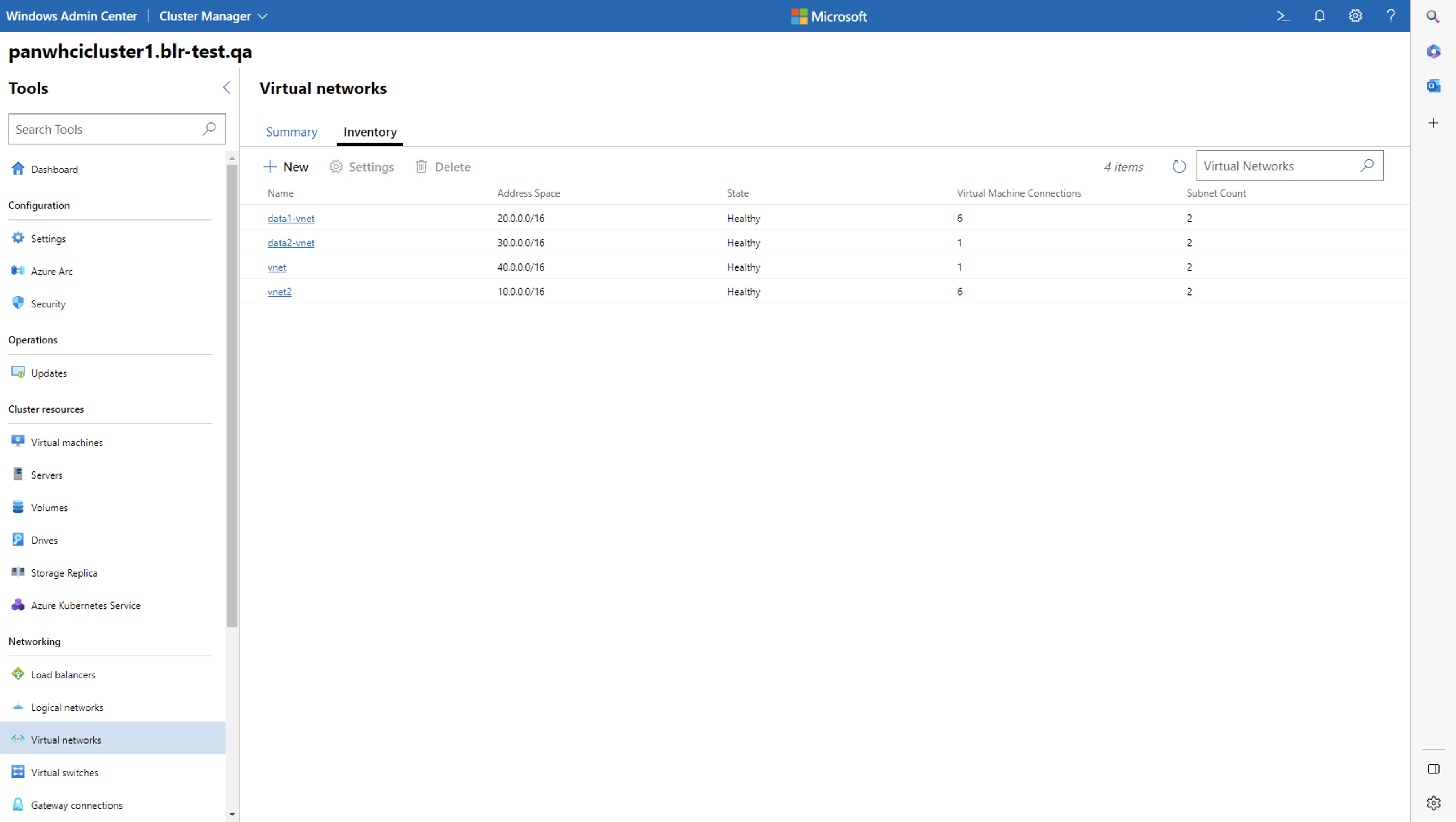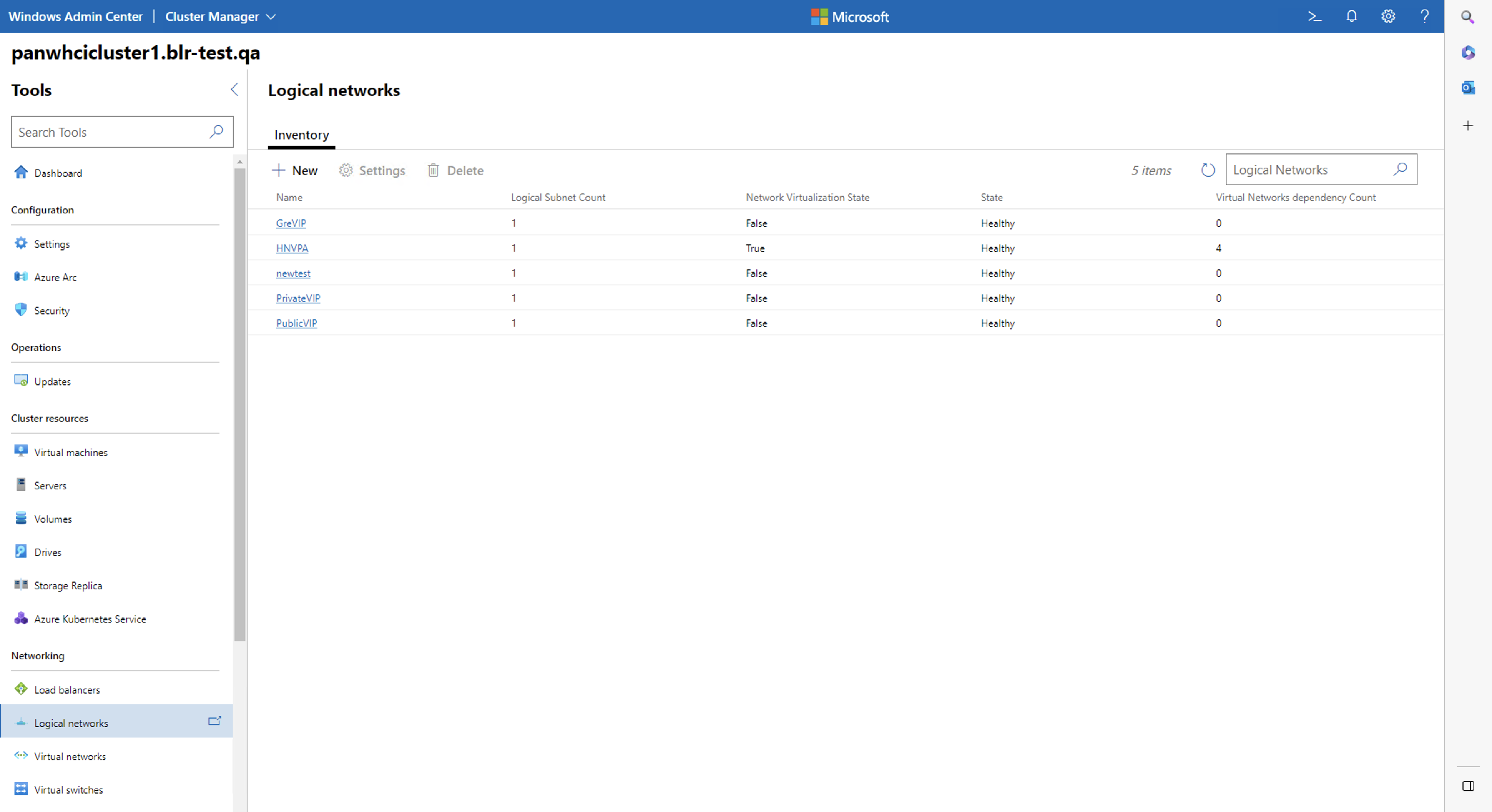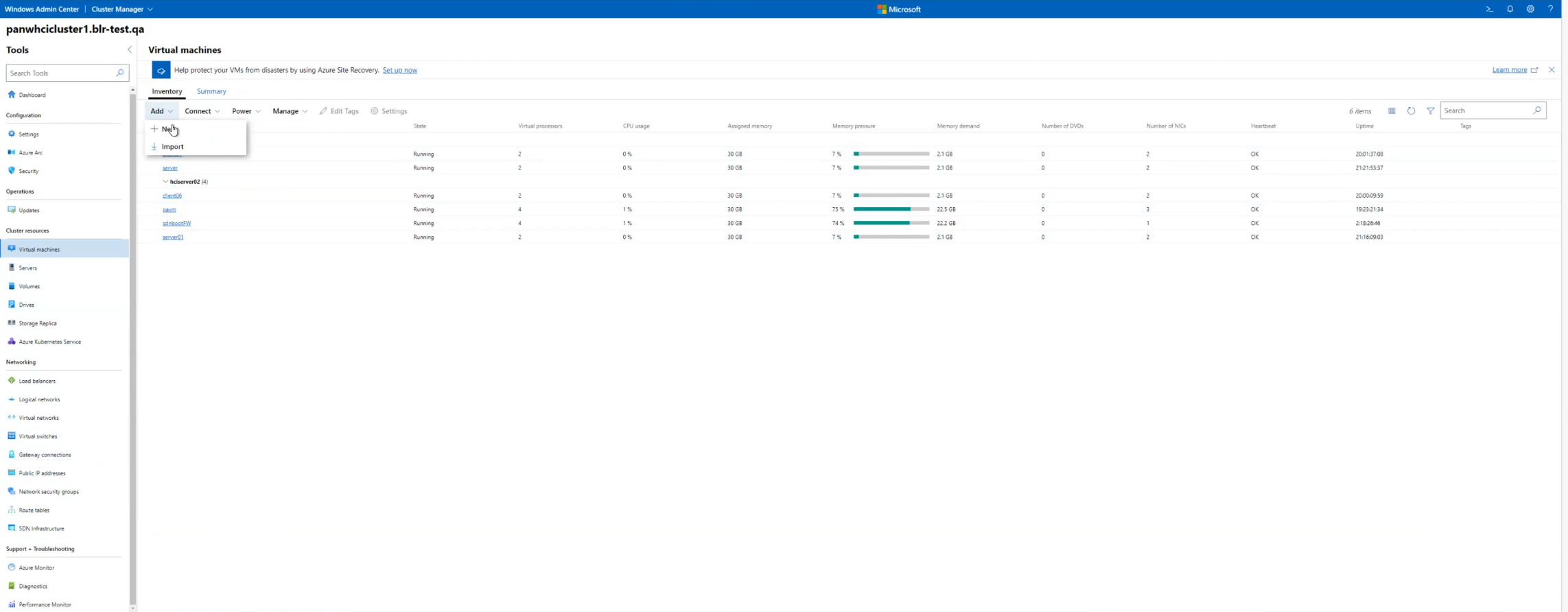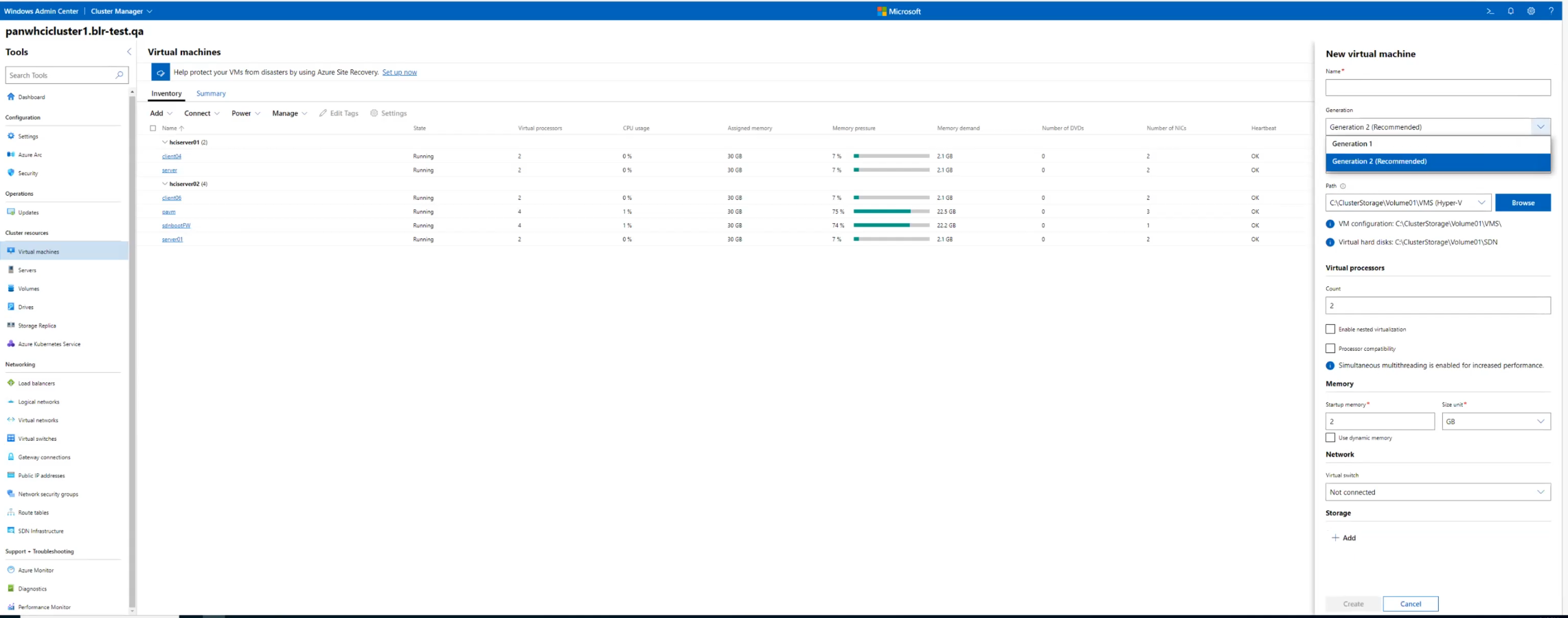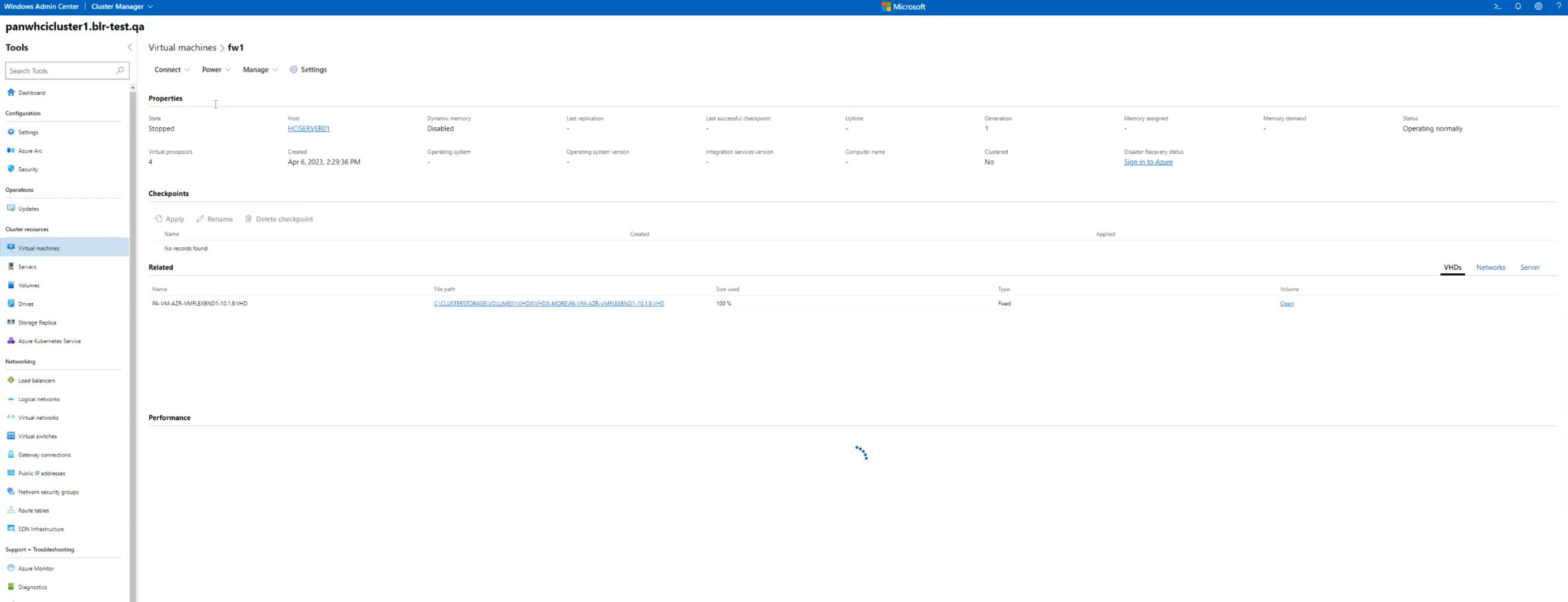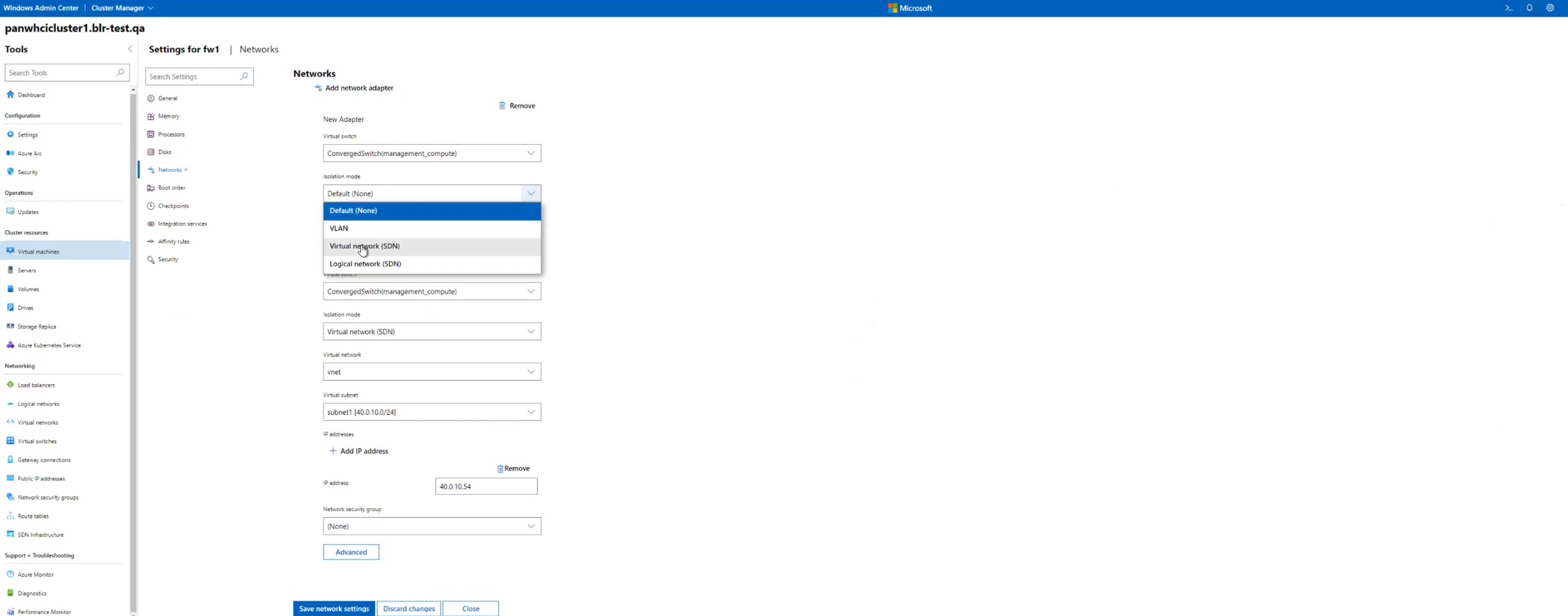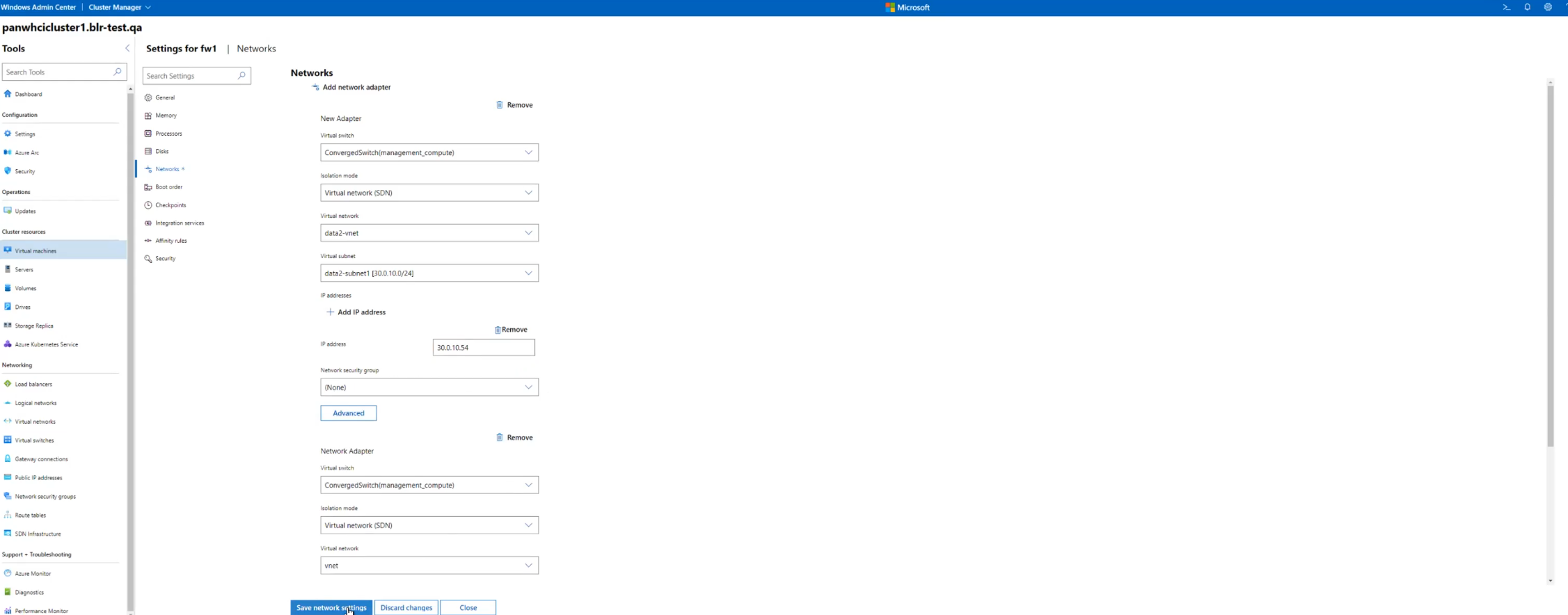Deploy the VM-Series Firewall on Azure Stack HCI
Table of Contents
Expand all | Collapse all
-
- VM-Series Deployments
- VM-Series in High Availability
- IPv6 Support on Public Cloud
- Enable Jumbo Frames on the VM-Series Firewall
- Hypervisor Assigned MAC Addresses
- Custom PAN-OS Metrics Published for Monitoring
- Interface Used for Accessing External Services on the VM-Series Firewall
- PacketMMAP and DPDK Driver Support
- Enable NUMA Performance Optimization on the VM-Series
- Enable ZRAM on the VM-Series Firewall
-
- Licensing and Prerequisites for Virtual Systems Support on VM-Series
- System Requirements for Virtual Systems Support on VM-Series
- Enable Multiple Virtual Systems Support on VM-Series Firewall
- Enable Multiple Virtual Systems Support on VM-Series in Panorama Console
- Enable Multiple Virtual Systems Support Using Bootstrap Method
-
- VM-Series Firewall Licensing
- Create a Support Account
- Serial Number and CPU ID Format for the VM-Series Firewall
- Use Panorama-Based Software Firewall License Management
-
- Activate Credits
- Create a Deployment Profile
- Activate the Deployment Profile
- Manage a Deployment Profile
- Register the VM-Series Firewall (Software NGFW Credits)
- Provision Panorama
- Migrate Panorama to a Software NGFW License
- Transfer Credits
- Renew Your Software NGFW Credits
- Deactivate License (Software NGFW Credits)
- Delicense Ungracefully Terminated Firewalls
- Set the Number of Licensed vCPUs
- Customize Dataplane Cores
- Migrate a Firewall to a Flexible VM-Series License
-
- Generate Your OAuth Client Credentials
- Manage Deployment Profiles Using the Licensing API
- Create a Deployment Profile Using the Licensing API
- Update a Deployment Profile Using the Licensing API
- Get Serial Numbers Associated with an Authcode Using the API
- Deactivate a VM-Series Firewall Using the API
- What Happens When Licenses Expire?
-
- Supported Deployments on VMware vSphere Hypervisor (ESXi)
-
- Plan the Interfaces for the VM-Series for ESXi
- Provision the VM-Series Firewall on an ESXi Server
- Perform Initial Configuration on the VM-Series on ESXi
- Add Additional Disk Space to the VM-Series Firewall
- Use VMware Tools on the VM-Series Firewall on ESXi and vCloud Air
- Use vMotion to Move the VM-Series Firewall Between Hosts
- Use the VM-Series CLI to Swap the Management Interface on ESXi
- Configure Link Aggregation Control Protocol
- ESXi Simplified Onboarding
-
-
- Supported Deployments of the VM-Series Firewall on VMware NSX-T (North-South)
- Components of the VM-Series Firewall on NSX-T (North-South)
-
- Install the Panorama Plugin for VMware NSX
- Enable Communication Between NSX-T Manager and Panorama
- Create Template Stacks and Device Groups on Panorama
- Configure the Service Definition on Panorama
- Deploy the VM-Series Firewall
- Direct Traffic to the VM-Series Firewall
- Apply Security Policy to the VM-Series Firewall on NSX-T
- Use vMotion to Move the VM-Series Firewall Between Hosts
- Extend Security Policy from NSX-V to NSX-T
-
- Components of the VM-Series Firewall on NSX-T (East-West)
- VM-Series Firewall on NSX-T (East-West) Integration
- Supported Deployments of the VM-Series Firewall on VMware NSX-T (East-West)
-
- Install the Panorama Plugin for VMware NSX
- Enable Communication Between NSX-T Manager and Panorama
- Create Template Stacks and Device Groups on Panorama
- Configure the Service Definition on Panorama
- Launch the VM-Series Firewall on NSX-T (East-West)
- Add a Service Chain
- Direct Traffic to the VM-Series Firewall
- Apply Security Policies to the VM-Series Firewall on NSX-T (East-West)
- Use vMotion to Move the VM-Series Firewall Between Hosts
-
- Install the Panorama Plugin for VMware NSX
- Enable Communication Between NSX-T Manager and Panorama
- Create Template Stacks and Device Groups on Panorama
- Configure the Service Definition on Panorama
- Launch the VM-Series Firewall on NSX-T (East-West)
- Create Dynamic Address Groups
- Create Dynamic Address Group Membership Criteria
- Generate Steering Policy
- Generate Steering Rules
- Delete a Service Definition from Panorama
- Migrate from VM-Series on NSX-T Operation to Security Centric Deployment
- Extend Security Policy from NSX-V to NSX-T
- Use In-Place Migration to Move Your VM-Series from NSX-V to NSX-T
-
-
- Deployments Supported on AWS
-
- Planning Worksheet for the VM-Series in the AWS VPC
- Launch the VM-Series Firewall on AWS
- Launch the VM-Series Firewall on AWS Outpost
- Create a Custom Amazon Machine Image (AMI)
- Encrypt EBS Volume for the VM-Series Firewall on AWS
- Use the VM-Series Firewall CLI to Swap the Management Interface
- Enable CloudWatch Monitoring on the VM-Series Firewall
- Publish ENA Network Performance Metrics to AWS CloudWatch
- VM-Series Firewall Startup and Health Logs on AWS
- Simplified Onboarding of VM-Series Firewall on AWS
- Use AWS Secrets Manager to Store VM-Series Certificates
- AWS Shared VPC Monitoring
- Use Case: Secure the EC2 Instances in the AWS Cloud
- Use Case: Use Dynamic Address Groups to Secure New EC2 Instances within the VPC
-
- Intelligent Traffic Offload
- Software Cut-through Based Offload
-
- Deployments Supported on Azure
- Deploy the VM-Series Firewall from the Azure Marketplace (Solution Template)
- Simplified Onboarding of VM-Series Firewall on Azure
- Deploy the VM-Series Firewall from the Azure China Marketplace (Solution Template)
- Deploy the VM-Series with the Azure Gateway Load Balancer
- Create a Custom VM-Series Image for Azure
- Deploy the VM-Series Firewall on Azure Stack
- Deploy the VM-Series Firewall on Azure Stack HCI
- Enable Azure Application Insights on the VM-Series Firewall
- Azure Health Monitoring
- Set up Active/Passive HA on Azure
- Use Azure Key Vault to Store VM-Series Certificates
- Use the ARM Template to Deploy the VM-Series Firewall
-
- About the VM-Series Firewall on Google Cloud Platform
- Supported Deployments on Google Cloud Platform
- Create a Custom VM-Series Firewall Image for Google Cloud Platform
- Prepare to Set Up VM-Series Firewalls on Google Public Cloud
-
- Deploy the VM-Series Firewall from Google Cloud Platform Marketplace
- Management Interface Swap for Google Cloud Platform Load Balancing
- Use the VM-Series Firewall CLI to Swap the Management Interface
- Enable Google Stackdriver Monitoring on the VM Series Firewall
- Enable VM Monitoring to Track VM Changes on Google Cloud Platform (GCP)
- Use Dynamic Address Groups to Secure Instances Within the VPC
- Use Custom Templates or the gcloud CLI to Deploy the VM-Series Firewall
- Enable Session Resiliency on VM-Series for GCP
- Secure Boot Support for VM-Series on GCP
-
- Prepare Your ACI Environment for Integration
-
-
- Create a Virtual Router and Security Zone
- Configure the Network Interfaces
- Configure a Static Default Route
- Create Address Objects for the EPGs
- Create Security Policy Rules
- Create a VLAN Pool and Domain
- Configure an Interface Policy for LLDP and LACP for East-West Traffic
- Establish the Connection Between the Firewall and ACI Fabric
- Create a VRF and Bridge Domain
- Create an L4-L7 Device
- Create a Policy-Based Redirect
- Create and Apply a Service Graph Template
-
- Create a VLAN Pool and External Routed Domain
- Configure an Interface Policy for LLDP and LACP for North-South Traffic
- Create an External Routed Network
- Configure Subnets to Advertise to the External Firewall
- Create an Outbound Contract
- Create an Inbound Web Contract
- Apply Outbound and Inbound Contracts to the EPGs
- Create a Virtual Router and Security Zone for North-South Traffic
- Configure the Network Interfaces
- Configure Route Redistribution and OSPF
- Configure NAT for External Connections
-
-
- Choose a Bootstrap Method
- VM-Series Firewall Bootstrap Workflow
- Bootstrap Package
- Bootstrap Configuration Files
- Bootstrapping VM-Series in Virtual Metadata Collector Mode
- Generate the VM Auth Key on Panorama
- Create the bootstrap.xml File
- Prepare the Licenses for Bootstrapping
- Prepare the Bootstrap Package
- Bootstrap the VM-Series Firewall on AWS
- Bootstrap the VM-Series Firewall on Azure
- Bootstrap the VM-Series Firewall on Azure Stack HCI
- Bootstrap the VM-Series Firewall on Google Cloud Platform
- Verify Bootstrap Completion
- Bootstrap Errors
Deploy the VM-Series Firewall on Azure Stack HCI
You can deploy the VM-Series firewall on Azure Stack HCI within Software Defined
Networking (SDN) architecture. Azure Stack HCI is a hyperconverged infrastructure (HCI)
cluster solution that hosts virtualized Windows and Linux workloads and their storage in
a hybrid environment that combines on-premises infrastructure with Azure cloud services.
For more information, see Azure Stack HCI solution overview.
You can deploy the VM-Series firewall on Azure Stack HCI and protect the inbound traffic,
outbound traffic, and east-west traffic between various vNETs. The VM-Series firewall
traffic is pinned to an active interface with an out-of-band management interface, where
the internal applications and inbound traffic are routed through route tables to force
traffic through the firewall load balancer for east-west and north-south traffic to
provide internal micro segmentation and a security perimeter. The SDN Gateway then
allows traffic to pass in and out of the internal SDN via the Hub vNet.
Perform the following steps to deploy the VM-Series firewall on Azure Stack HCI SDN:
- To get started, you will need the following:
- One or more servers from the Azure Stack HCI Catalog and Azure subscription.
- Operating system licenses for your workload VMs – for example, Windows Server. See Activate Windows Server VMs.
- An internet connection for each server in the cluster that can connect via HTTPS outbound traffic to well-known Azure endpoints at least every 30 days. See Azure connectivity requirements for more information.
- For clusters stretched across sites :
- At least one 1 Gb connection between sites (a 25 GB RDMA connection is preferred)
- At least four severs (two in each site)
- An average latency of 5 ms round trip between sites if you want to do synchronous replication where writes occur simultaneously in both sites.
- To use SDN infrastructure, you need a virtual hard disk (VHD) for the Azure Stack HCI operating system to create Network Controller, Multiplexer, and Gateway VMs on Management Network (see Plan to deploy Network Controller, Deploy SDN Software Load Balancer, and Deploy SDN Gateway ).
For more information, see What you need for Azure Stack HCI. - Create an Azure Stack HCI cluster using any one of the below given methods:
- Using Windows Admin Center. For more information, see Create an Azure Stack HCI cluster using Windows Admin Center.
- Using Windows Powershell. For more information, see Create an Azure Stack HCI cluster using Windows PowerShell.
- Register Azure Stack HCI cluster with Azure for monitoring, support, billing, and hybrid services.
- Deploy the SDN infrastructure using any one of the following methods:After successfully deploying the SDN infrastructure, go to the SDN Infrastructure dashboard on your Windows Admin Center and ensure that all server nodes are healthy.This document considers the Windows Admin Center option for deploying VM-Series firewall.
![]()
- After deploying the SDN infrastructure, create a Hyper-V Network Virtualization (HNV) virtual network.
![]()
![]()
- Deploy the VM-Series firewall. Download the VHDX file. Register your VM-Series firewall and obtain the VHDX file.
- Filter by PAN-OS for VM-Series Base Images and download the VHDX file. For example, PA-VM-HPV-7.1.0.vhdx.
- Install the VM-Series firewall.Perform the following steps to install the VM-Series firewall on Azure Stack HCI:Add a virtual machine.
- Go to Windows Admin Center > Cluster Manager and select the Cluster.
- Go to Virtual Machines > Add> New.
![]() Configure the following settings in the New Virtual Machine Wizard:
Configure the following settings in the New Virtual Machine Wizard:- Enter Name for the VM-Series firewall.
- Select Generation 1. This is the default option and the only version supported.
![]()
- Select the Host and Path for the VM-Series firewall. Browse
the VHD/VHDX FW image file. Note: You must store the VHD/VHDX in location C:/ClusterStorage/Volumes.
- For Startup Memory, assign the memory based on the VM-Series System Requirements of your VM-Series model.
- To configure networking, from the Virtual Network dropdown menu,
select vNet.A converged virtual switch (vSwitch) gets created while bringing up the Azure Stack HCI cluster.
- Select Virtual Switch > Isolation Mode > Virtual Network > Virtual Subnet.
- Click Add IP Address and enter the IP address for the management interface.
- Select Network Security Group (optional).
- To connect the Virtual Hard Disk, select Use an existing virtual hard disk and browse to the VHDX file you downloaded earlier in Step 6.
- Click Create.
- After successfully installing the VM-Series firewall on the cluster, you can add more Network Adapters for data traffic. Perform the following to add a Network Adapter:
- Select your VM, go to Settings > Network.
![]()
- Click Add Network Adapter.
![]()
- Select Virtual Switch > Isolation Mode > Virtual Network > Virtual Subnet.
- Click Add IP Address and enter the IP address for the data interface.
- Select Network Security Group (optional).
- Click Save Network Settings.
![]() Connect at least one network adapter for the data interface on the firewall. You can create and add more Network Adapters using the same steps above.
Connect at least one network adapter for the data interface on the firewall. You can create and add more Network Adapters using the same steps above.
- Select your VM, go to Settings > Network.
- (Optional) Enable MAC address spoofing if you are not using Layer 3 with MAC
address.
- Double click the dataplane virtual network adapter and click Advanced Settings.
- Click the Enable MAC address spoofing check box and click Apply.
- Bootstrap the VM-Series Firewall on Azure Stack HCI.
- Power on the firewall.
![]()

